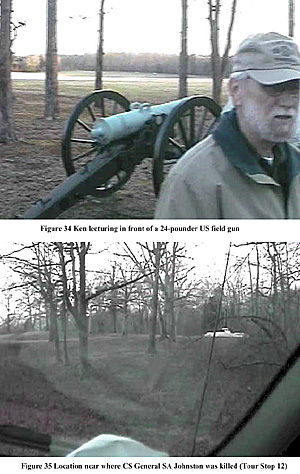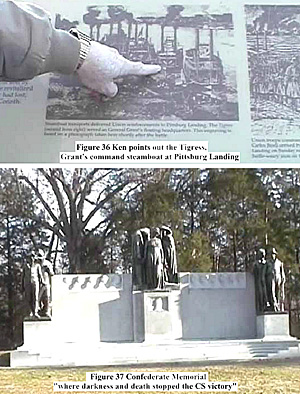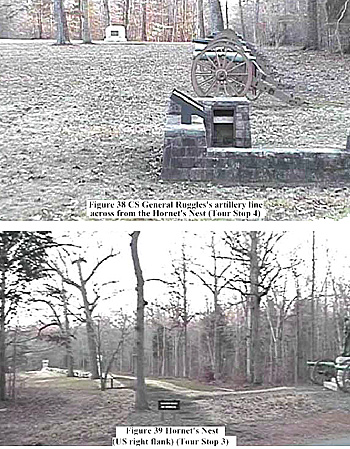 Today is 6 December and I am driving from Chattanooga to Memphis with a long stop at
the Shiloh National Battlefield Park that is near Savannah, Tn. and north of Corinth, Mi.
I had made arrangements to meet at the visitors’ centre with my guide for the battlefield
tour, Ken Hansgen. We agreed to meet at 1300 hours; however, I did not arrive until
1330 because of a few wrong turns along the route. I wrongly took Interstate 59 instead
of continuing along I-24 to Highway #72, which crosses northern Alabama. I had to ask
for directions at the Alabama tourist centre on I-59 and then take Highway 40 to
Scottsdale to join #72.
Today is 6 December and I am driving from Chattanooga to Memphis with a long stop at
the Shiloh National Battlefield Park that is near Savannah, Tn. and north of Corinth, Mi.
I had made arrangements to meet at the visitors’ centre with my guide for the battlefield
tour, Ken Hansgen. We agreed to meet at 1300 hours; however, I did not arrive until
1330 because of a few wrong turns along the route. I wrongly took Interstate 59 instead
of continuing along I-24 to Highway #72, which crosses northern Alabama. I had to ask
for directions at the Alabama tourist centre on I-59 and then take Highway 40 to
Scottsdale to join #72.
Once on #72, it was easy to reach Savannah (by way of #20 and #69) and continue to Crump’s Landing and take the road south to the park. This is a good route because there are few major roads between Chattanooga and Shiloh without going back to Middle Tennessee and then joining #64 that continues past Shiloh to Memphis. Savannah is where US General US Grant’s HQ (Cherry Mansion) is located. Crump’s Landing is where US General L Wallace (author of “Ben-Hur”) and his division were sent to guard the west bank of the Tennessee River and from where he marched to join the battle on the evening of the first day’s fighting.
I arrived at the visitors’ centre and reported to the front desk, where the ranger informed me that Ken had already been there and would return after going to the local post office. I toured the museum and then watched the movie about the battle produced many years ago (it was really old as it was made in the late 1950’s). At the end of this 25-minute film, I met Ken at the front desk (and apologised for my tardiness) and he took me through the museum and pointed out certain exhibits including a diorama of US soldiers defending from the left of the Hornet’s Nest (Tour Stop 13). It was about 1400 and the official tour was underway.
The day had started cool and cloudy. Now it was sunny and warm (about 54F), and much better for sightseeing.
 This was my first guided tour by a local person. I had been part of a ranger-guided tour
at Gettysburg on my first visit to that park, but that was as a member of a group of
friends. This was my first solo tour. Ken had been living in the area for several years
and had bought a house in Savannah, which became his retirement home after he and his wife decided to move from California. Ken wanted to become a guide prior to the move, and the purchase of the house made Shiloh his battle of choice. Of course, he had to
educate himself thoroughly before doing his first tour and he is very good at it. He can
recite passages from the many accounts of the battle and even quote personal comments
made during the battle. His knowledge is vast and includes trivia about many of the sites
in the park. In addition, he is an experienced skirmish re-enactor so he knows a lot about
the weapons, and gives a detailed lecture on the ACW artillery. The park was initially
controlled by the army and benefited from military administration in that it is now the
home of a good collection of vintage artillery pieces.
This was my first guided tour by a local person. I had been part of a ranger-guided tour
at Gettysburg on my first visit to that park, but that was as a member of a group of
friends. This was my first solo tour. Ken had been living in the area for several years
and had bought a house in Savannah, which became his retirement home after he and his wife decided to move from California. Ken wanted to become a guide prior to the move, and the purchase of the house made Shiloh his battle of choice. Of course, he had to
educate himself thoroughly before doing his first tour and he is very good at it. He can
recite passages from the many accounts of the battle and even quote personal comments
made during the battle. His knowledge is vast and includes trivia about many of the sites
in the park. In addition, he is an experienced skirmish re-enactor so he knows a lot about
the weapons, and gives a detailed lecture on the ACW artillery. The park was initially
controlled by the army and benefited from military administration in that it is now the
home of a good collection of vintage artillery pieces.
From the museum, we crossed to the bookstore where Ken recommended his favourites including a detailed topographical map of the battlefield, the “Visitors Guide Blue & Gray Shiloh” (written by park historian Stacy D Allen), and “Civil War Stories” by Ambrose Bierce (who fought in the battle). I added a copy of “Shiloh Bloody April” by Wiley Sword, which Ken considers the most detailed account of the battle, and a CD-ROM on the war (because it includes many paintings by Mort Kunstler).
We started the tour down at Pittsburg Landing and visited all but two of the stops (Fraley Field #8 and Union Defence Line #9). Time was our enemy as it got dark by 1645, so Ken tailored the tour such that I saw the majority of the stops in daylight (I was filming the tour). Ken also recorded his presentation on an audiocassette on my mini-tape recorder.
We drove down to Pittsburg Landing, where the majority of Grant’s army landed and then waited for the arrival of US General DC Buell and his army from Nashville. Ken related how it got its name; there was a family of a father and two sons or three brothers of whom one went by the nickname of Pitt. They provided shipping on the river with supplies and so it became known as Pittsburg Landing. Not quite as grand as the Cumberland Gap!
Ken provided lots of anecdotes during the tour. At the river, one was about US General W “Bull” Nelson (commanding the 4 th Division of Buell’s army) mounting his horse in the bow of the boat and leading his men ashore. This must have been an amazing sight as Nelson stood about 6’5” and weighed some 300 pounds! He also gave an art lecture at the Confederate Monument near the area where the survivors of the divisions of US Generals WHL Wallace and Prentiss surrendered (and Wallace was killed). The monument is at the “high-water mark” of the battle for the Confederates. The monument is full of symbols such as the depicting of figures representing the infantry, cavalry, artillery and officers at the two ends, and the representation of all eleven Confederate states amid rolling waves.
 Of interest, the artilleryman has his hand on the left shoulder of the infantryman indicating the support given by the former to the latter. The central figure (the model was a 17-year old Kentucky girl) represents the Confederacy with the laurel wreath in her right hand being taken away by the shrouded figure of death (CS General AS Johnston and many other CS soldiers) and flanked on the left by night. Both are credited for “snatching defeat from the jaws of
victory”.
Of interest, the artilleryman has his hand on the left shoulder of the infantryman indicating the support given by the former to the latter. The central figure (the model was a 17-year old Kentucky girl) represents the Confederacy with the laurel wreath in her right hand being taken away by the shrouded figure of death (CS General AS Johnston and many other CS soldiers) and flanked on the left by night. Both are credited for “snatching defeat from the jaws of
victory”.
I left the park with a much better understanding of the battle. It was on a scale with Waterloo in terms of men involved and there were more casualties inflicted than all previous US conflicts before the civil war began. Of note, Shiloh is one of the few national military cemeteries to have Confederate soldiers buried in it. Since the CS troops were in rebellion against the US government, they could not be buried within such sacred ground. Pointed gravestones that stand out from the rounded ones for the other soldiers mark their graves. Ken states the shape was chosen so that no Yankees could sit on Confederates.
I said my good-bye to Ken at the visitors centre upon completion of an excellent three-hour tour (just like the ill-fated Minnow of “Gilligan’s Island”). I continued west on #64 to Memphis for the night. Along the way, I had to detour around the annual Bolivar Christmas parade as it was conducted along the main street, coincidently #64!
Postscript: Today is Sunday, 7 December and I have decided to visit Graceland, the home of Elvis Aaron Presley. I mention this because of the date and the fact that Elvis made a donation to the USS Arizona memorial in Pearl Harbour, Hawaii. It also happened to be the 35 th anniversary year of his 1968 “Comeback” Tour and the 30 th anniversary year of his 1973 “Aloha” Tour, which took place in Hawaii. Elvis liked Hawaii by the way.
Back to Sabretache # 6 Table of Contents
Back to Sabretache List of Issues
Back to MagWeb Master Magazine List
© Copyright 2003 by Terry Gore
This article appears in MagWeb.com (Magazine Web) on the Internet World Wide Web. Other articles from military history and related magazines are available at http://www.magweb.com